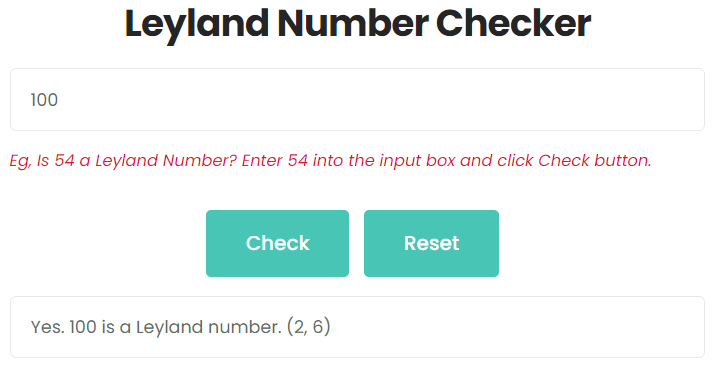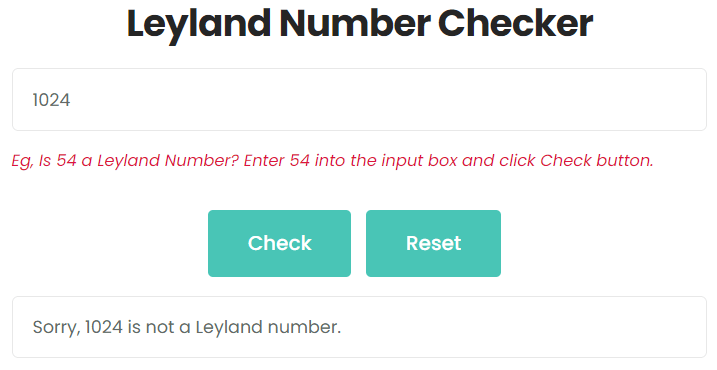Welcome to our Leyland number checker! In this article, we will delve into the intriguing world of Leyland numbers, exploring their definition, properties, and how to determine whether a given number is a Leyland number. Let’s dive in!
What is a Leyland Number
A Leyland number is a positive integer that can be expressed in the form xy + yx, where x and y are integers greater than 1. Leyland numbers were first introduced by Paul Leyland, a British mathematician, and they exhibit fascinating properties and relationships between integers and exponents.
How to Check the Leyland Number
To check if a number is a Leyland number, follow these steps:
- Start with the given number n.
- Iterate through all possible combinations of numbers x and y.
- Calculate the value of xy + yx.
- If the calculated value matches the input number n, then it is a Leyland number.
- If no match is found after exhausting all combinations, the number is not a Leyland number.
Example:
Let’s check if the number 17 is a Leyland number.
Try different combinations of x and y: (2, 2), (2, 3), (2, 4), (2, 5), …
Calculate xy + yx for each combination.
23 + 32 = 8 + 9 = 17
Calculated values matches 17.
Therefore, 17 is a Leyland number.
What is the Leyland Number Checker
The Leyland number checker is a specialized tool that automates the process of determining whether a number is a Leyland number. It simplifies the calculations and saves time and effort by applying an efficient algorithm to explore all possible combinations of numbers x and y. With the Leyland number checker, you can quickly verify if a given number belongs to this intriguing class of numbers.
How to Use the Leyland Number Checker
Using the Leyland number checker is straightforward:
- Enter the number you want to check into the designated input field.
- Click the Check button to initiate the verification process.
- Click the Reset button to start a new verification.
The checker will analyze the number using the Leyland number algorithm. The result will be displayed, indicating whether the number is a Leyland number or not.
Solved Examples by the Checker
Here are a few examples of numbers and their Leyland number status as determined by the checker:
Example 1:
Is 100 a Leyland Number?
Enter 100 into the input box and click Check button. As shown in the figure, 100 is a Leyland number.

Example 2:
Is 1024 a Leyland Number?
Enter 1024 into the input box and click Check button. As shown in the figure, 1024 is not a Leyland number.

FAQs
- Q1: Can a Leyland number have multiple valid combinations of prime numbers x and y?A: Yes, a Leyland number can have multiple valid combinations. For example, 17 can be expressed as 23 + 32 or as 32 + 23.
- Q2: Are all Leyland numbers prime numbers?A: No, not all Leyland numbers are prime numbers. Some Leyland numbers are composite numbers.
- Q3: Can a Leyland number be a perfect square?A: Yes, there are Leyland numbers that are perfect squares. For example, 100 is a Leyland number since 26 + 62 equals 100.
- Q4: Can a Leyland number be negative?A: No, by convention, Leyland numbers are defined as positive integers. Negative numbers are not considered Leyland numbers.
Conclusion
In conclusion, Leyland numbers provide a captivating glimpse into the connections between integers and exponents. With the Leyland number checker, you can easily verify if a number belongs to this unique class. Explore the world of Leyland numbers, uncover their properties, and enjoy the journey of discovery in the realm of number theory.
Latest Checkers
Check if the given number is an almost perfect number.
Latest Calculators
Standard Form to Slope-Intercept Form Calculator
Slope Intercept Form Calculator
Slope Calculator: Calculate Slope, X-Intercept, Y-Intercept
Reciprocal of Complex Number Calculator
Conjugate Complex Number Calculator
Modulus of Complex Number Calculator
Profit Percentage Calculator: Calculate Your Profitability Easily
Attendance and Absence Percentage Calculator